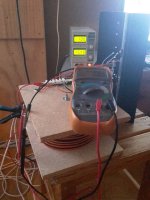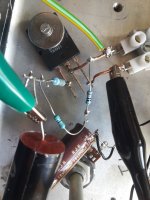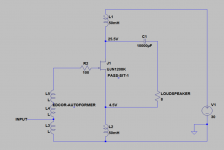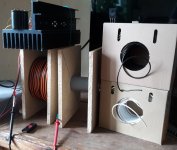This split load phasesplitter output would be a nice output stage after an Edcor transformer for voltage-gain. Something like the M2 but with only one N channel fet at the output.
With the right power supply voltage and the right DCR on the bifilar choke one could use a self-biasing depletion mode SiC Jfet.
I count 5 parts and a power-supply for each channel. 😎
Cheers,
Johannes
With the right power supply voltage and the right DCR on the bifilar choke one could use a self-biasing depletion mode SiC Jfet.
I count 5 parts and a power-supply for each channel. 😎
Cheers,
Johannes
include some cojones
If I where to use an IRFP7430 and an Edcor transformer as a step-up autotransformer then I guess I would need some additional "cojones" in the driving stage. My soundcard (M-Audio Revo 7.1) seems quite good at driving the gate capacitance of the IRFP7430 and IXTH140P05T in both common source and common drain.
How I wish I had hoarded Jfets while the Jfets hoarding was good. I have a small stash, but not enough that I want to use them for my experiments.
Cheers,
Johannes
I believe so , if you say so ........ me not having experience with those mosfets
however - generally - cleverly tweaked bjt Diamond buffer (yes, I know - it needs bipolar supply) is next best thing after complementary JFet buffer
however - generally - cleverly tweaked bjt Diamond buffer (yes, I know - it needs bipolar supply) is next best thing after complementary JFet buffer

This is fun!
I substituted my large transfomer-core bifilar choke with my air-cored bifilar choke and the sound quality increased substantially.
With only 2 x 16 mH calculated inductance and 1.4 ohm DCR for each winding I did not anticipate much bass. I know the LTSpice simulation predicts a good bass-response but it is very surprising to hear deep electronic bass notes from Sub6 and Gyu play effortless and with good dynamics and definition.
I can't test the amp much tonight since my kids and wife is going to sleep now, but there is absolutely no lack of bass. Neither quantity or quality.
The best thing is that everybody can easily wind two 100 meter parallel strands of 1.5 mm2 pvc-coated electric wire around a pvc-tube. This bifilar choke is cheap and very easy to build. I don't know how much power it can take before getting to hot, but I guess I could easily build a 30 watt class A split load phase-splitter based amp with it.
Cheers,
Johannes

I substituted the rather strange IRFP7430 for a Ixys IXTK100N25P Polar mosfet.
I want to hear the amplifier without the strong personality of the IRFP7430, and I am not disappointed at all. It seems to need more current then the IRFP7430. With less then 700 mA the gain drops substantially. At 1.0 ampere it sounds very nice with the IXTK100N25P.
Once again I am reminded how nice those Ixys Polar-fets are.
The IRFP7430 seems much more suited to common source amps without global negative feedback.
Cheers,
Johannes
This is one strange amplifier.....
With 1010 mA current the amp sounds very nice. Fast clean and very easy to like. Music just flows effortless. I can listen for 3 hours and just want more. It is not as good as the PCF Zen amp I have developed in another thread, even though it is a perfectly nice amp.
I am driving it directly from the output of my soundcard and it is loud enough to listen to music all the way across our house while cooking food. The bass is good. Reasonably dynamic and clean.
With 1100 mA or more something strange happens. All of a sudden the amp just "opens up" and starts to play with vigour and joy. I have no idea why there is such a sharp line between a reasonably nice amp and a amp full of life, nice emotions, joy and dancing.
I am playing The Orb - Moonbuilding 2703 AD quite loud and I love it.
I can't really fine any changes in tonal qualities or in the perceived amount of or lack of distortion. The difference seems to be only in the dynamic character of the amp. It is like drinking the same kind of wine at home or anchored in a nice cove at sunset after a long day of beautiful and fun sailing.... At home it might be a nice wine, while you will savour the exquisite wine and really enjoy every last drop of it while you slowly give in to the tired fulfilling feeling after a long day of sailing and start prepare for some well deserved rest.
I can't get my head around this amp. It is quite strange, but not necessarily in a bad way...
Cheers,
Johannes
With 1010 mA current the amp sounds very nice. Fast clean and very easy to like. Music just flows effortless. I can listen for 3 hours and just want more. It is not as good as the PCF Zen amp I have developed in another thread, even though it is a perfectly nice amp.
I am driving it directly from the output of my soundcard and it is loud enough to listen to music all the way across our house while cooking food. The bass is good. Reasonably dynamic and clean.
With 1100 mA or more something strange happens. All of a sudden the amp just "opens up" and starts to play with vigour and joy. I have no idea why there is such a sharp line between a reasonably nice amp and a amp full of life, nice emotions, joy and dancing.
I am playing The Orb - Moonbuilding 2703 AD quite loud and I love it.
I can't really fine any changes in tonal qualities or in the perceived amount of or lack of distortion. The difference seems to be only in the dynamic character of the amp. It is like drinking the same kind of wine at home or anchored in a nice cove at sunset after a long day of beautiful and fun sailing.... At home it might be a nice wine, while you will savour the exquisite wine and really enjoy every last drop of it while you slowly give in to the tired fulfilling feeling after a long day of sailing and start prepare for some well deserved rest.
I can't get my head around this amp. It is quite strange, but not necessarily in a bad way...
Cheers,
Johannes
Today I got a Fairchild HUF 75332P3 55 volt Ultrafet from my son. He salvaged it from a switching regulator of some kind.
I tried it in this simple amp and it sounded very nice with as little as 250 mA of steady current (not enough heat-sink for more current in this quick and dirty test). It worked very nice with a clear and somewhat bright sound for 5 minutes and then it all become quiet. I accidentally short-circuited the drain to gate with a alligator-clip. I guess the large choke created a high voltage spike of some kind, since the mosfet died, despite the low 15 volts from the power-supply.
😡
Johannes
I tried it in this simple amp and it sounded very nice with as little as 250 mA of steady current (not enough heat-sink for more current in this quick and dirty test). It worked very nice with a clear and somewhat bright sound for 5 minutes and then it all become quiet. I accidentally short-circuited the drain to gate with a alligator-clip. I guess the large choke created a high voltage spike of some kind, since the mosfet died, despite the low 15 volts from the power-supply.
😡
Johannes
I fired up this amp again today. I use the old IXYS IXTK100N25P as I did before the test with the Fairchild HUF I accidentally blew up by shorting a lead across the pins. I wanted to compare it with the bastode PCF simple Zen amp from my other thread.
It is one strange amp. It does not behave like I believe it should.
With only 1020 mA it sound nice and clean. Very enjoyable but a bit laid back, boring and dull. I have heard much worse though. With 1100 mA or more it starts to play with a whole other level of authority. It is a strange behaviour. I would not believe this if I had not experienced it several times.
Today I increased the quiescent current to 1250 mA and my lab power supply got quite hot. A little to hot to touch more then a few seconds.
I hope I can build a better powersupply soon. I need 20 volt and about 2 ampere per channel. I hope this will sound even better. I am very happy with 1.2 ampere, except for the powersupply heat.
It does not have an character of its own like the IRFP7430 or the schade-feedback bastode PCF Zen amp. It is much cleaner and more transparent. The bass is much better with an almost frightening authority. Very powerful and solid. No bloom or resonant behaviour.
With more then 1.2 ampere of current I prefer this split load phasesplitter amp to all other amps I have built. The simple PCF Zen amp comes in at close second.
Cheers,
Johannes
It is one strange amp. It does not behave like I believe it should.
With only 1020 mA it sound nice and clean. Very enjoyable but a bit laid back, boring and dull. I have heard much worse though. With 1100 mA or more it starts to play with a whole other level of authority. It is a strange behaviour. I would not believe this if I had not experienced it several times.
Today I increased the quiescent current to 1250 mA and my lab power supply got quite hot. A little to hot to touch more then a few seconds.
I hope I can build a better powersupply soon. I need 20 volt and about 2 ampere per channel. I hope this will sound even better. I am very happy with 1.2 ampere, except for the powersupply heat.
It does not have an character of its own like the IRFP7430 or the schade-feedback bastode PCF Zen amp. It is much cleaner and more transparent. The bass is much better with an almost frightening authority. Very powerful and solid. No bloom or resonant behaviour.
With more then 1.2 ampere of current I prefer this split load phasesplitter amp to all other amps I have built. The simple PCF Zen amp comes in at close second.
Cheers,
Johannes
Hi there! I've been reading this thread with some curiosity; I was reading about MOSFET phase splitters in the tube forum, and somehow ended up here.
That said, what you've got there is simple enough for me to whip up easily enough, as long as I can use a surplus torroid's primary(or secondary) windings instead of your bifilar choke. I don't see why I couldn't though...
That said, what you've got there is simple enough for me to whip up easily enough, as long as I can use a surplus torroid's primary(or secondary) windings instead of your bifilar choke. I don't see why I couldn't though...
A mains transformer - a toroid primary and secondary windings can't take the constant DC current. It will magnetize the core. I tried with a somewhat aircored diy-winded transformer and the results where lackluster and dull.
The amp needs a aircored bifilar choke. It does not need a lot of inductance. Only 20 - 30 mH per winding.
Buy two 300 foot 1,5 mm2 pvc-coated wire (awg # 15) and wind it bifilar around a piece of pvc pipe between two square pieces of mdf/particleboard/plywood. It takes two hours and will give superior results compared to a mains transformer.
Cheers,
Johannes
The amp needs a aircored bifilar choke. It does not need a lot of inductance. Only 20 - 30 mH per winding.
Buy two 300 foot 1,5 mm2 pvc-coated wire (awg # 15) and wind it bifilar around a piece of pvc pipe between two square pieces of mdf/particleboard/plywood. It takes two hours and will give superior results compared to a mains transformer.
Cheers,
Johannes
I thought if the primaries were wired out of phase, the flux would balance, and no saturation of the core would result.
http://www.firstwatt.com/pdf/art_zv7.pdf as an example of dc being balanced allowing the primaries to be used as large inductors. Towards the bottom of the article...
http://www.firstwatt.com/pdf/art_zv7.pdf as an example of dc being balanced allowing the primaries to be used as large inductors. Towards the bottom of the article...
Last edited:
Today I tried an IRFP7430 in this amp. This time with the large air-cored bifilar choke.
The results are interesting and strange once again....
The bass is a little subdued compared to the quite bass-heavy Ixys IXTK100N25P, but at the same time I find it go deeper with more control and authority. It is more of a slight change in flavor to more control and firmness.
The midbass, midrange and treble is improved with a large dose of the very "alive" and vivid character I often get from the IRFP7430, but this time without the pronounced character and coloration the IRFP7430 is prone to produce. It just sounds very open, clear and alive. No effort.
It is still much cleaner and more neutral compared to the Bastode PCF Zen amp I have built and tested in another thread, but the large fun and life-like vividness and feeling of the music being "alive" is somewhere halfway between the Split load phasesplitter amp with the IXTK100N25P and the no feedback Zen amp with the IRFP7430.
The IRFP7430 is one strange and fun mosfet. I really urge everyone to buy a few and try them out. They behave like an opera diva. They demand much but once they are happy they can really perform. Once you hear them at their best you will forgive them their strong, demanding and distinctive personality.
Cheers,
Johannes
The results are interesting and strange once again....
The bass is a little subdued compared to the quite bass-heavy Ixys IXTK100N25P, but at the same time I find it go deeper with more control and authority. It is more of a slight change in flavor to more control and firmness.
The midbass, midrange and treble is improved with a large dose of the very "alive" and vivid character I often get from the IRFP7430, but this time without the pronounced character and coloration the IRFP7430 is prone to produce. It just sounds very open, clear and alive. No effort.
It is still much cleaner and more neutral compared to the Bastode PCF Zen amp I have built and tested in another thread, but the large fun and life-like vividness and feeling of the music being "alive" is somewhere halfway between the Split load phasesplitter amp with the IXTK100N25P and the no feedback Zen amp with the IRFP7430.
The IRFP7430 is one strange and fun mosfet. I really urge everyone to buy a few and try them out. They behave like an opera diva. They demand much but once they are happy they can really perform. Once you hear them at their best you will forgive them their strong, demanding and distinctive personality.
Cheers,
Johannes
Today I have been testing this amp with the infamous IRFP7430 mosfet but with another powersupply.
With 27.5 volts from the powersupply, 24.4 volts Vds over the mosfet and 1.1 ampere through the amp it is a whole other amp once again.
The mosfet gets very hot. I can't touch it for more then one second, but this is due to a small heatsink. I don't want to rebuild this amp just to test an idea.
The IRFP7430 seems much more linear with 24 volts Vds. It is still very vivid and "alive".
Everything is presented large and physically present. I guess this is similar to Nelson Pass SIT amps, even though I imagine they sound much better considering the large and nonlinear capacitance of the IRFP7430.
The treble is improved substantially with higher voltage across the device. Still a little harsh and edgy when there is lots of energy in the treble region. This is usually not much of a problem with rock and pop music, but violins and classical music can be a little hard and edgy. I am listening to Patricia Barbers record Smash and it sounds marvelous. Very dynamic, large, lifelike and entertaining.
Cheers,
Johannes
With 27.5 volts from the powersupply, 24.4 volts Vds over the mosfet and 1.1 ampere through the amp it is a whole other amp once again.
The mosfet gets very hot. I can't touch it for more then one second, but this is due to a small heatsink. I don't want to rebuild this amp just to test an idea.
The IRFP7430 seems much more linear with 24 volts Vds. It is still very vivid and "alive".
Everything is presented large and physically present. I guess this is similar to Nelson Pass SIT amps, even though I imagine they sound much better considering the large and nonlinear capacitance of the IRFP7430.
The treble is improved substantially with higher voltage across the device. Still a little harsh and edgy when there is lots of energy in the treble region. This is usually not much of a problem with rock and pop music, but violins and classical music can be a little hard and edgy. I am listening to Patricia Barbers record Smash and it sounds marvelous. Very dynamic, large, lifelike and entertaining.
Cheers,
Johannes
Hi Johannes
i use a roll of 100m 3 wire cable for domestic house cabling, made a connection with only 2 wires in phase reversal chokes, left the 3rd unused.
Measure the resonance of that roll with 400pF in parallel, 131.7kHz, so the inductance is around 3.65mH.
I connected the IRFP7430 to a 24v DC, gate was settled to 3.61v, a compromised to best bias for thermal stability. Ids was 0.6A.
Music reproduced by that setting is very "pure and bright", will find a way to increase my inductance to near your calculation, then going to take some measurements.
Well, thanks for sharing your work,my respect Johannes.
The outstanding sound quality from one fet and a roll of electrical wire, wasn't bothered to do hard yard to build a choke, is hard to believe.

i use a roll of 100m 3 wire cable for domestic house cabling, made a connection with only 2 wires in phase reversal chokes, left the 3rd unused.
Measure the resonance of that roll with 400pF in parallel, 131.7kHz, so the inductance is around 3.65mH.
I connected the IRFP7430 to a 24v DC, gate was settled to 3.61v, a compromised to best bias for thermal stability. Ids was 0.6A.
Music reproduced by that setting is very "pure and bright", will find a way to increase my inductance to near your calculation, then going to take some measurements.
Well, thanks for sharing your work,my respect Johannes.
The outstanding sound quality from one fet and a roll of electrical wire, wasn't bothered to do hard yard to build a choke, is hard to believe.

That large roll of cable is to spread out to create any substantial inductance. If you pack two strands of pvc coated wire in a tight coil the inductance goes up.
With only 3.65 mH and 0.6 ampere it should sound very bright and thin. Especially so with the IRFP7430. The IRFP7430 needs more current then 0.6 ampere.
Try connecting two of the three strands of wire in series and use them as the top inductance connected to drain.
The third and last should be connected i reverse phase and to the source.
This way you use all the available cable in that large roll.
Both the gain and distortion will increase a little.
Thanks for trying my ideas.
Cheers,
Johannes
With only 3.65 mH and 0.6 ampere it should sound very bright and thin. Especially so with the IRFP7430. The IRFP7430 needs more current then 0.6 ampere.
Try connecting two of the three strands of wire in series and use them as the top inductance connected to drain.
The third and last should be connected i reverse phase and to the source.
This way you use all the available cable in that large roll.
Both the gain and distortion will increase a little.
Thanks for trying my ideas.
Cheers,
Johannes
- Home
- Amplifiers
- Pass Labs
- Split load phasesplitter amplifier with bifilar choke load



